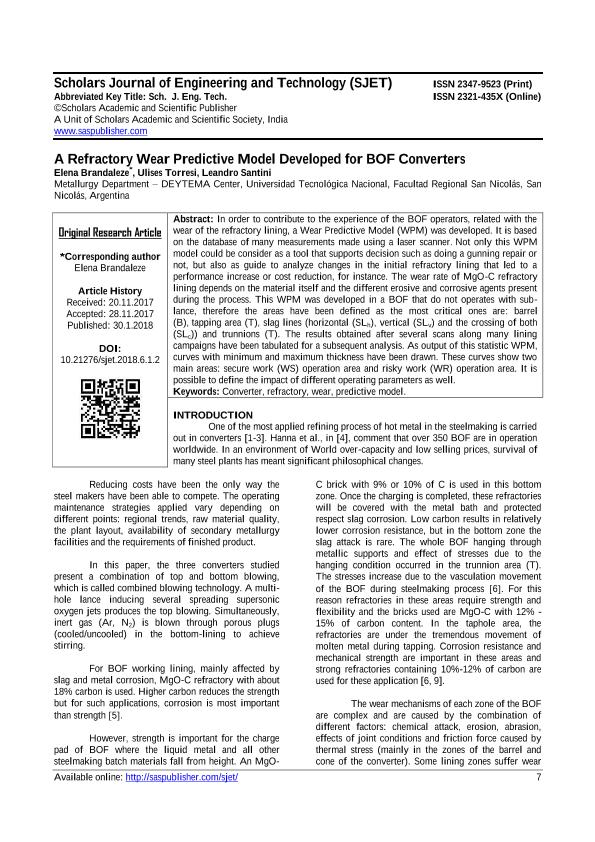Mostrar el registro sencillo del ítem
dc.contributor.author
Brandaleze, Elena

dc.contributor.author
Torresi Domínguez, Ulises
dc.contributor.author
Santini, Leandro Matias

dc.date.available
2020-04-01T19:41:21Z
dc.date.issued
2018-01
dc.identifier.citation
Brandaleze, Elena; Torresi Domínguez, Ulises; Santini, Leandro Matias; A refractory wear predictive model developed for BOF converters; Scholars Academic and Scientific Publisher; Scholars Journal of Engineering and Technology; 6; 1-2018; 7-13
dc.identifier.issn
2321-435X
dc.identifier.uri
http://hdl.handle.net/11336/101571
dc.description.abstract
In order to contribute to the experience of the BOF operators, related with the wear of the refractory lining, a Wear Predictive Model (WPM) was developed. It is based on the database of many measurements made using a laser scanner. Not only this WPM model could be consider as a tool that supports decision such as doing a gunning repair or not, but also as guide to analyze changes in the initial refractory lining that led to a performance increase or cost reduction, for instance. The wear rate of MgO-C refractory lining depends on the material itself and the different erosive and corrosive agents present during the process. This WPM was developed in a BOF that do not operates with sublance, therefore the areas have been defined as the most critical ones are: barrel (B), tapping area (T), slag lines (horizontal (SLh), vertical (SLv) and the crossing of both (SLc)) and trunnions (T). The results obtained after several scans along many lining campaigns have been tabulated for a subsequent analysis. As output of this statistic WPM, curves with minimum and maximum thickness have been drawn. These curves show two main areas: secure work (WS) operation area and risky work (WR) operation area. It is possible to define the impact of different operating parameters as well. Keywords: Converter, refractory, wear, predictive model.
dc.format
application/pdf
dc.language.iso
eng
dc.publisher
Scholars Academic and Scientific Publisher
dc.rights
info:eu-repo/semantics/openAccess
dc.rights.uri
https://creativecommons.org/licenses/by-nc/2.5/ar/
dc.subject
CONVERTER
dc.subject
REFRACTORY
dc.subject
WEAR
dc.subject
PREDICTIVE MODEL
dc.subject.classification
Cerámicos

dc.subject.classification
Ingeniería de los Materiales

dc.subject.classification
INGENIERÍAS Y TECNOLOGÍAS

dc.subject.classification
Otras Ingeniería de los Materiales

dc.subject.classification
Ingeniería de los Materiales

dc.subject.classification
INGENIERÍAS Y TECNOLOGÍAS

dc.title
A refractory wear predictive model developed for BOF converters
dc.type
info:eu-repo/semantics/article
dc.type
info:ar-repo/semantics/artículo
dc.type
info:eu-repo/semantics/publishedVersion
dc.date.updated
2020-03-13T13:35:36Z
dc.identifier.eissn
2347-9523
dc.journal.volume
6
dc.journal.pagination
7-13
dc.journal.pais
India

dc.description.fil
Fil: Brandaleze, Elena. Universidad Tecnológica Nacional. Facultad Regional San Nicolás. Centro para el Desarrollo Tecnológico de Materiales; Argentina. Consejo Nacional de Investigaciones Científicas y Técnicas; Argentina
dc.description.fil
Fil: Torresi Domínguez, Ulises. Universidad Tecnológica Nacional. Facultad Regional San Nicolás. Centro para el Desarrollo Tecnológico de Materiales; Argentina. Consejo Nacional de Investigaciones Científicas y Técnicas; Argentina
dc.description.fil
Fil: Santini, Leandro Matias. Consejo Nacional de Investigaciones Científicas y Técnicas; Argentina. Universidad Tecnológica Nacional. Facultad Regional San Nicolás. Centro para el Desarrollo Tecnológico de Materiales; Argentina
dc.journal.title
Scholars Journal of Engineering and Technology
dc.relation.alternativeid
info:eu-repo/semantics/altIdentifier/doi/http://dx.doi.org/10.21276/sjet.2018.6.1.2
dc.relation.alternativeid
info:eu-repo/semantics/altIdentifier/url/http://saspublisher.com/sjet-61/
Archivos asociados
